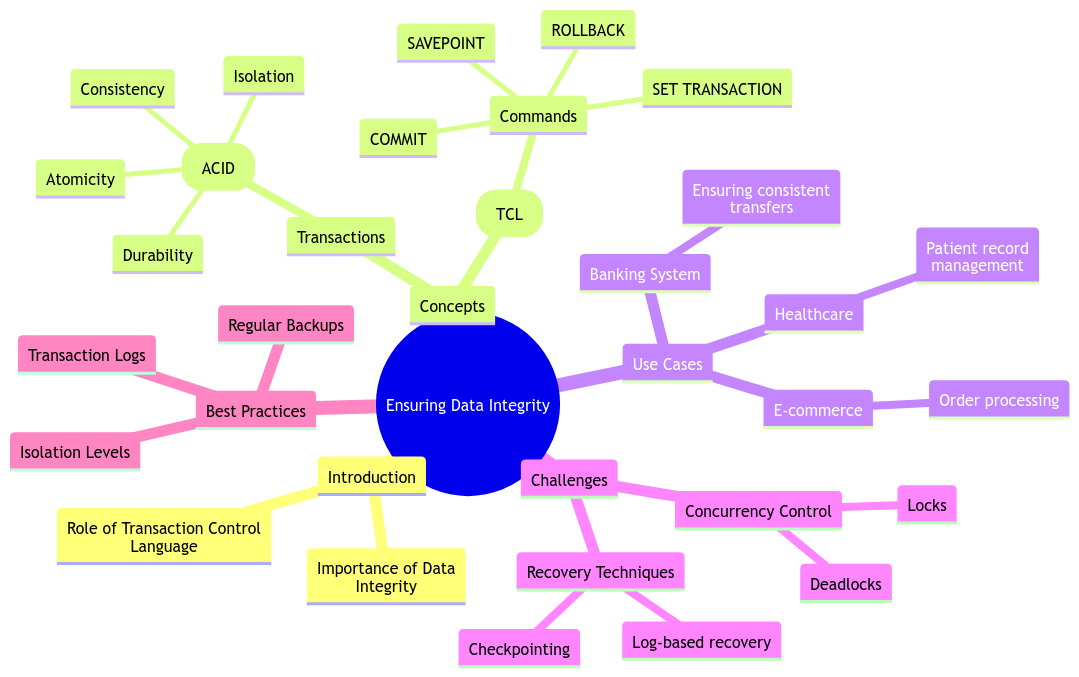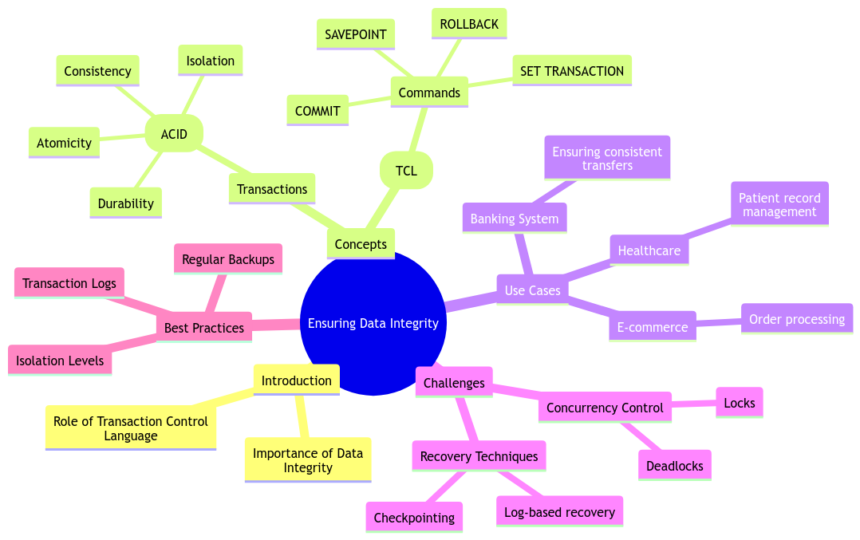Ensuring Data Integrity: An Introduction to Transaction Control Language
In today’s data-driven world, ensuring data integrity is key to maintaining reliable and trustworthy information systems. 📊 Data integrity refers to the accuracy, consistency, and reliability of data throughout its lifecycle. Imagine if your favorite food delivery app suddenly mixed up your order history or if your playlist on a music streaming platform started playing random songs instead of your carefully curated list – chaos, right? That’s why data integrity matters! 🍔🎶
Importance of Data Integrity
Significance of Data Integrity
Data integrity ensures that data remains unchanged from its source and is accurately stored and retrieved. It’s like making sure that your BFF’s secret recipe for the best chocolate chip cookies stays intact and doesn’t get messed up along the way. 🍪✨
Impact of Poor Data Integrity
On the flip side, poor data integrity can lead to disastrous consequences. Think of a bank mistakenly adding an extra zero to your account balance or a healthcare system mixing up patient records – not a pretty picture! Poor data integrity can erode trust, damage reputation, and result in costly mistakes. 💸💔
Understanding Transaction Control Language (TCL)
Definition and Purpose of TCL
Transaction Control Language, or TCL in geek terms, is a set of commands used to manage transactions in a database. It’s like having a magical wand (well, more like a keyboard) to control how changes are made to the database. With TCL, you can group a set of database operations into a single unit to ensure data consistency and reliability. ✨🔮
Common Commands used in TCL
TCL provides some nifty commands to work its magic:
- COMMIT: Finalizes the transaction, making all changes permanent. It’s like sealing a deal – once committed, there’s no turning back! ✔️
- ROLLBACK: Closes the transaction and undoes any changes made within that transaction. It’s your Ctrl+Z in the database world – a quick fix when things go awry. ↩️
- SAVEPOINT: Sets a point in the transaction to which you can roll back. It’s like dropping a pin on a map – a checkpoint for your data journey. 📍
Benefits of Using Transaction Control Language
Ensuring Data Consistency
TCL ensures that database transactions are processed reliably and consistently. It’s like having a strict teacher in the classroom – making sure that every student (in this case, every data operation) follows the rules to maintain order and harmony. 📚🧑🏫
Enhancing Data Security
By controlling how transactions are executed, TCL plays a vital role in enhancing data security. It’s like having a vigilant security guard at the entrance of a party – filtering out any shady characters and allowing only trusted guests to enter. 🔒🕵️♂️
Challenges in Implementing Transaction Control Language
Complexity of TCL Commands
Let’s face it – TCL commands can sometimes feel like deciphering a cryptic code. The syntax can be tricky, and one wrong move might lead to chaos in the database universe. It’s like trying to navigate through a maze with a blindfold on – challenging, to say the least! 🧩😅
Ensuring Proper Error Handling
Handling errors in a database transaction is crucial but can be daunting. Imagine juggling multiple balls in the air – drop one, and the whole show might come crashing down! Proper error handling is like having a safety net to catch those falling data bits before they hit the ground. 🤹♂️🪀
Best Practices for Implementing Transaction Control Language
Transaction Design Guidelines
- Keep it Simple: Stick to clear and concise transactions to avoid confusion.
- Use Savepoints Wisely: Set savepoints strategically to enable efficient rollback options.
- Test, Test, Test: Always test your transactions to catch any bugs before they wreak havoc in production. 🐞🛠️
Monitoring and Auditing Transactions
- Regular Monitoring: Keep a close eye on transactions to detect any unusual behavior early on.
- Audit Trails: Maintain detailed audit logs to track transaction history and troubleshoot issues effectively. 📝🔍
In closing, mastering Transaction Control Language is like becoming the wizard of the database realm – wielding power to ensure data integrity and security. So, embrace TCL with open arms, navigate its challenges with a sprinkle of humor, and watch your data kingdom thrive! 🌟🚀
Thank you for joining me on this hilarious yet insightful journey through the whimsical world of Transaction Control Language! Remember, keep your data safe and your SQL queries snappy! ✨💻🔒

Program Code – Ensuring Data Integrity: An Introduction to Transaction Control Language
-- Transaction Control Language (TCL) operations in SQL
-- Begin Transaction: Mark the starting point of a transaction.
BEGIN TRANSACTION;
-- SQL Operations here (INSERT, UPDATE, DELETE etc.) that modify the database.
-- Let's assume we are updating account balances in a banking system.
UPDATE Accounts SET balance = balance - 100 WHERE account_number = '12345X';
UPDATE Accounts SET balance = balance + 100 WHERE account_number = '67890Y';
-- Savepoint: Establishes a savepoint within a transaction.
SAVEPOINT TransferCheckpoint;
-- More SQL Operations if needed, showing an erroneous operation for demonstration
UPDATE Accounts SET balance = balance - 50 WHERE account_number = 'INVALID_ACCOUNT';
-- Rollback to Savepoint: Undo operations to the savepoint in case of an error.
ROLLBACK TO TransferCheckpoint;
-- Commit Transaction: If everything goes correctly, commit the transaction.
COMMIT;
-- Another Transaction to demonstrate Rollback
BEGIN TRANSACTION;
UPDATE Accounts SET balance = balance - 500 WHERE account_number = '12345X';
-- Pretend something went wrong, and we decide not to proceed
ROLLBACK;
Code Output:
The code does not produce a direct output since it’s SQL transaction control operations, but the expected result is:
- The balance of account ‘12345X’ is decreased by $100, and ‘67890Y’ increased by $100.
- An attempt to incorrectly update an ‘INVALID_ACCOUNT’ is made but is rolled back to the last savepoint, effectively cancelling this erroneous update.
- A transaction attempting to remove $500 from ‘12345X’ is rolled back, leaving the account balances as after the first COMMIT.
Code Explanation:
The program demonstrates the fundamental concepts of Transaction Control Language (TCL) operations within relational database management using SQL.
- BEGIN TRANSACTION marks the start of a transaction, a sequence of operations performed as a single unit. This ensures that all operations within the transaction are completed successfully before making permanent changes to the database (commitment), or none are applied at all (rollback), maintaining database integrity.
- UPDATE statements alter account balances, simulating financial transactions. The essence of demonstrating transactions is to ensure these updates either all succeed or fail together, preserving the consistency of financial records.
- SAVEPOINT creates a checkpoint within the transaction, allowing partial rollbacks to this point. It’s useful for complex transactions where certain operations might fail but shouldn’t abort the entire transaction.
- ROLLBACK TO reverses operations to the most recent savepoint when an error is detected, without aborting the entire transaction. This showcases error handling within transactions, ensuring consistency even when parts of the transaction fail.
- COMMIT finalizes all changes made during the transaction, making them permanent. Commitment signifies a successful transaction where all operations are guaranteed to have succeeded.
- Another transaction example illustrates a ROLLBACK without a savepoint, which undoes all operations since the transaction began. It demonstrates transaction cancellation in response to errors or checks failing.
This code effectively encapsulates how TCL operations manage data integrity and consistency within databases through transaction demarcation, savepoints, error handling with rollback to savepoints, and the crucial decision between committing to apply changes permanently or rolling back to maintain the pre-transaction state.
Frequently Asked Questions
What is Transaction Control Language (TCL) in the context of databases?
Transaction Control Language (TCL) is a set of commands used to manage transactions in a database. These commands help ensure data integrity by controlling the changes made to the database and managing the transactions effectively.
How does Transaction Control Language (TCL) contribute to ensuring data integrity?
TCL commands like COMMIT, ROLLBACK, and SAVEPOINT play a crucial role in maintaining data integrity in a database system. COMMIT is used to save the changes made during a transaction, ROLLBACK reverts the database to its state before the transaction, and SAVEPOINT provides a point to which a transaction can be rolled back.
Can you provide examples of Transaction Control Language (TCL) commands and their usage?
Certainly! An example of a TCL command is COMMIT, which is used to save the changes made during a transaction. Another example is ROLLBACK, which is used to undo the changes made during a transaction and restore the database to its previous state.
Why is understanding Transaction Control Language (TCL) important for database management?
Understanding TCL is essential for database administrators to maintain data consistency and integrity. By using TCL commands effectively, administrators can ensure that the database transactions are managed correctly, reducing the risk of data corruption or loss.
How can beginners learn and practice Transaction Control Language (TCL) commands?
Beginners can start by learning the basic TCL commands such as COMMIT, ROLLBACK, and SAVEPOINT. They can practice using these commands in a database management system to understand how transactions are managed and how data integrity is maintained through TCL operations.







